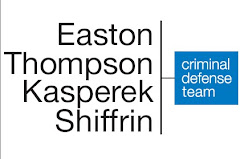Last week's post discussed People v Jones (2015 NY Slip Op 09773), in which the Appellate Division, Fourth Department, reversed a conviction in the interest of justice due to numerous acts of prosecutorial misconduct in summation which were egregious, but largely unpreserved by timely objection. That is obviously a great result for Mr. Jones and his appellate attorney (good work, Catherine Josh). And it allows trial counsel to join in celebrating the client's reversal.
But defense counsel who fail to object to prejudicial misconduct in summation risk other results.
The worst possibility is that the appellate court might decline to exercise its discretionary jurisdiction to reverse in the interest of justice on an issue that might have merited reversal if the error had been preserved for review as a matter of law.
There is another possibility in which the defendant is granted a new trial and appellate counsel might be happy with the results, but in which trial counsel is not likely to feel too good -- the appellate court might reverse for ineffective assistance of counsel based on trial counsel's failure to timely object to prosecutorial misconduct.
Thrice in recent years, the Court of Appeals has reversed convictions on findings of ineffective assistance of counsel based, at least in part, on the failure to object to prejudicial prosecutorial misconduct in summation.
As discussed in detail here, in People v Fisher (2012 NY Slip Op 02416 [4/3/12]) the Court of Appeals reversed convictions for various sex offenses and ordered a new trial upon a finding that the defendant's trial attorney rendered ineffective assistance of counsel by failing to object to the prosecutor's summation was egregiously improper and there was no evident strategic basis for counsel's failure to object. The Court wrote that
Even when viewed in the "totality" of the representation provided defendant, defense counsel's failure to object to any, let alone all, of the prosecutor's egregiously improper departures during summation, particularly in the highly charged, potentially outcome determinative context in which they occurred, deprived defendant of the right to effective assistance of counsel (see People v Baldi, 54 NY2d 137, 146-147 [1981]). We see no strategic basis for counsel's failure to object to these highly prejudicial instances of prosecutorial abuse, in critical respects utterly attenuated from the evidence and the applicable principles of law.
Then, in People v Oathout (2013 NY Slip Op 03122 [21 NY3d 127] [5/3/13]), the Court reversed on a finding of ineffective assistance of counsel, in part, based on counsel's failure to object to multiple acts of misconduct in summation
He failed to object to the prosecutor's vouching for Lugo's credibility when the prosecutor told the jury that the police would not keep using her as a confidential informant if she were not credible. He also failed to object when the prosecutor pointed out to the jury that defendant, who did not testify at trial, took notes with his left hand during the trial and continued to theorize how the crime was consistent with its commission by a left-handed person—like defendant. Defense counsel failed to object despite the fact that there was no evidence presented either that defendant was left-handed or that the crime was committed by a left-handed person.
Most recently, in People v Wright (2015 NY Slip Op 05621 [25 NY3d 769] [7/1/15]), the Court, citing Oathout, reversed a conviction on a finding that defense counsel's ineffective assistance of counsel deprived the defendant of a fair trial when counsel defense counsel failed to object, time and again, when the prosecutor repeatedly misrepresented to the jury critical DNA evidence as proof of defendant's guilt by suggesting that the evidence directly linked defendant to the murder although it did not.
Again, the good news is that in all three cases there was ultimately a reversal. But in all three cases the defendant was convicted and lost his appeal at the Appellate Division. Thus, in all three cases the defendant spent years in prison prior to the reversal. All of that and a finding of ineffective assistance of counsel could have been avoided by timely objection to misconduct during summation.
However tempting it is to sit back and simply exhale after giving a defense summation, neither the defendant nor the defense counsel can afford to have counsel stop working during the prosecutor's summation, which is quite a critical stage of the trial.




